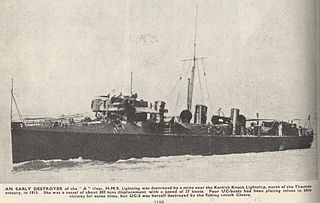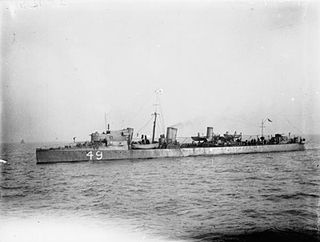Design and construction
Peterel was laid down (as Yard number 745) on 29 July 1898 by the Jarrow shipbuilder Palmers Shipbuilding and Iron Company Limited. Construction began 'on spec' (i.e. as a private venture by the builder without a specific order), but the part-built ship was included in a January 1899 tender by Palmers to supply three destroyers [lower-alpha 1] to the Royal Navy under a supplement to the 1899–1900 shipbuilding programme. [lower-alpha 2] The ship was launched on 30 March 1899 and Palmers' tender accepted in April 1899, the contract price being £47149 per ship. [1] [2]
Peterel closely resembled Spiteful, built by Palmers under the previous year's shipbuilding programme, and like Spiteful had four funnels. She was 219 feet 6 inches (66.90 m) long overall, with a beam of 20 feet 9 inches (6.32 m) and a draught of 8 feet 11 inches (2.72 m). Displacement was 370 long tons (380 t) light and 420 long tons (430 t) full load. [3] Four Reed boilers fed steam at 250 pounds per square inch (1,700 kPa) to triple expansion steam engines rated at 6,200 indicated horsepower (4,600 kW) and driving two propeller shafts, giving a speed of 30 knots (56 km/h; 35 mph). [4] [5] 91 tons of coal carried. [5]
Armament was a single QF 12 pounder 12 cwt (3 in-calibre or 76 mm) gun on a platform on the ship's conning tower (in practice the platform was also used as the ship's bridge), backed up by five 6-pounder guns, and two 18 inch (450 mm) torpedo tubes. [6] [7]
Service history
Peterel was delivered at Portsmouth in February 1900 for completion and armament [8] and was completed in July that year. [9] She took part in the 1901 Naval Manoeuvres. [10] In 1910 Peterel was a member of the 4th Destroyer Flotilla based at Portsmouth, remaining part of the flotilla in 1912. [11] On 30 August 1912 the Admiralty directed all destroyers were to be grouped into classes designated by letters based on contract speed and appearance. As a four-funneled 30-knotter destroyer, Peterel was assigned to the B Class. [12] [13]
In 1912, older destroyers were organised into Patrol Flotillas, with Peterel being part of the 6th Flotilla, based at Portsmouth, in March 1913. [14] [15]
HMS Kangaroo was a B-class torpedo boat destroyer of the British Royal Navy. She served with the Dover Patrol in the First World War.

HMS Spiteful was a Spiteful-class torpedo boat destroyer built at Jarrow, England, by Palmers Shipbuilding and Iron Company for the Royal Navy and launched in 1899. Specified to be able to steam at 30 knots, she spent her entire career serving in the seas around the British Isles.
HMS Success was a B-class torpedo boat destroyer of the Royal Navy. She was launched on 21 March 1901. On 27 December 1914 she was wrecked off Fife Ness during heavy gales.
HMS Boxer was an Ardent-class destroyer which served with the Royal Navy, launched on 28 November 1894. She spent several years operating with the Mediterranean Fleet and remained active during the First World War. She was sunk in a collision on 8 February 1918.

HMS Bruizer was an Ardent-class destroyer which served with the Royal Navy. She was launched on 27 February 1895 by John Thornycroft at Chiswick, and was sold on 26 May 1914.

HMS Charger was a Charger-class destroyer which served with the Royal Navy. She was launched by Yarrow Shipbuilders at Poplar, London on 15 September 1894, served in home waters and was sold off in 1912.
HMS Hasty was a Charger-class destroyer which served with the Royal Navy. She was launched by Yarrow Shipbuilders in 1894, served in home waters and was sold off in 1912.

HMS Dasher was a Charger-class destroyer which served with the Royal Navy. She was built by Yarrow Shipbuilders in 1895, served in home waters and was sold in 1911.

HMS Lightning was a Janus-class destroyer of the British Royal Navy, later designated an A-class destroyer, built by Palmers and launched in 1895.
HMS Porcupine was a Janus-class destroyer of the Royal Navy. She was launched by Palmers Shipbuilding and Iron Company in 1895, served in home waters and was in service during the First World War.

HMS Surly was a Rocket-class destroyer of the Royal Navy. She was launched at Clydebank in 1894, served in home waters and was sold in 1920.

HMS Sturgeon was the lead ship of the Sturgeon-class destroyers which served with the Royal Navy. Built by Vickers, she was launched in 1894 and sold in 1910.
HMS Myrmidon was one of two Myrmidon-class destroyers which served with the Royal Navy.
HMS Syren was one of two Myrmidon-class destroyers which served with the Royal Navy. She was launched by Palmers in 1900, served in home waters and was sold off, after the First World War, in 1920.
HMS Star was a Palmer three-funnel, 30-knot destroyer ordered by the Royal Navy under the 1896–1897 Naval Estimates. She was the eleventh ship to carry this name since it was introduced in 1643 for a 19-gun ship sold until 1652.

HMS Roebuck was a Hawthorn Leslie three-funnel, 30-knot destroyer ordered by the Royal Navy under the 1898–1899 Naval Estimates. She was the twelfth ship to carry the name. She served during World War I and was broken up in 1919.

HMS Dove was a three funnel, 30 knot destroyer ordered by the Royal Navy under the 1896–1897 Naval Estimates. She was the ninth ship to carry the name.
HMS Leopard was a Vickers three funnel - 30 knot destroyer ordered by the Royal Navy under the 1895 – 1896 Naval Estimates. She was the ninth ship to carry this name since it was introduced in 1635 for a 34-gun ship, captured by the Dutch in 1653.

HMS Flirt was a Palmer three funnel, 30 knot destroyer ordered by the Royal Navy under the 1896 – 1897 Naval Estimates. She was the fifth ship to carry this name since it was introduced in 1782 for a 14-gun brig in service until 1795.

HMS Kestrel was a Clydebank-built three funnelled 30-knot destroyer ordered by the Royal Navy under the 1895 – 1896 Naval Estimates. She was the fourth ship to carry this name since it was first used in 1846 for a brigantine.
This page is based on this
Wikipedia article Text is available under the
CC BY-SA 4.0 license; additional terms may apply.
Images, videos and audio are available under their respective licenses.










